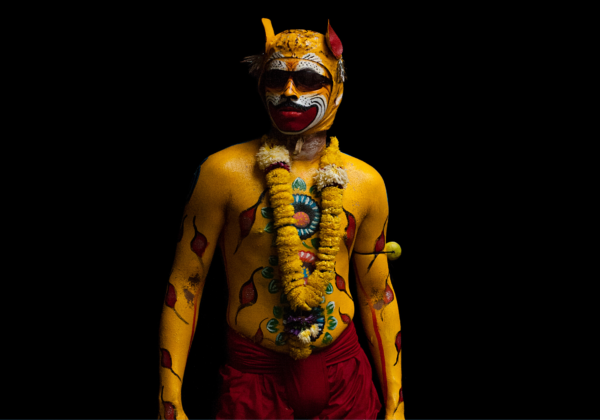Iwajla Klinke: On Humanity and Transformation
With an aesthetic precision similar to paintings of the Golden Age by Van Dyck and Caravaggio, Iwajla Klinke’s works strike a perfect harmony. The combinations of the dark backgrounds with models wearing wonderfully colored garments bring to light the various cultures around the world.
Klinke’s works, which focus on transformations and human rituals of passage rooted in masked costumes and traditions, elevate her art while questioning the choices we make and our place within society.
How Tradition Transforms One’s Self
The work of Iwajla Klinke combines tradition and modernity, which roots in her history and political science studies, as well as her Jewish and Islamic studies at Freie Universität in Berlin. Following her work for various TV stations in Tel Aviv, Gaza, Jordan, Italy, and Poland, Klinke made notable documentaries and transitioned into artistic photography.
By means of a dark background and simple yet deliberate portraits, the sacred clothing speaks for itself, allowing tradition and culture to be communicated. Numerous photoshoots, hundreds of rejected photographs, and minimal manipulation result in some organic and raw artworks rarely seen in the age of digital processing today.
Through her art, Klinke immortalizes forgotten cultural attire from the past in order to explore sacred traditions around the world, most of which are about the human transformation—such as of a child into an adult, or from an animal to a person.
Humanity has long engaged in rituals to achieve a wide variety of desired outcomes —
entering a new stage in life, reducing troubles and boosting confidence, alleviating grief, performing well for particular goals, a fertile harvest, and a thriving community through worship.
Notable Works
Using her camera, Iwajla Klinke has traveled to remote villages and valleys in Tyrol and Scottish islands, as well as Brazil, Mexico, and Africa. Among the places where Klinke has exhibited her work are Paris, Monaco, Barcelona, and Jerusalem. In 2014, she was awarded the Neuflize OBC Personnel Prize for her affinity with traditional clothing.
Her works, Therian Infantes III & IX, were taken during the Navaratri Festival in different areas of Karnataka, India. As part of this festival, boys dressed as tigers dance in the streets of their urban neighborhoods since Durga, the deity honored by this festival, is portrayed riding a tiger.
According to Klinke, this street culture of a human transforming into a mythic animal and vice versa has been found similarly “among young boys in Mexican suburbs, Guatemala, Panama, India, China, Japan, Indonesia, and so on.” The commonality among them is that the young boys usually participate in this youth culture until they get married.
In her other work, Tauromachy, she depicts young students attending bullfighting schools in Spain and Mexico, where it is common for boys to “transform” into a bull.
Klinke states that this particular portrait “represents a young Judean during a mourning procession on Good Friday centered around the death of Christ, all boys being dressed in red, while his mask refers at the same time to an ancient Mexican bull totem or deity.” She then incorporates modernity in the form of the famous US basketball team Chicago Bulls.
A Passion in Capturing Rituals
The relationship children have with death is very specific to Iwajla Klinke, “perhaps because children are not aware of death as we are.” This refers to Klinke’s fascination with using the youths as models for her artworks.
She states that many of the customs she documents have to do with the struggle between winter and spring, life and death — such as Easter, Carnival, most winter rituals, and fertility rites now passed on to Sukkot, Corpus Christi, Pentecost, and Shavuot, among others.
The beauty and symbolism of every detail in cultural garments and adornments captivate Klinke. To her, “These are sacred items, perhaps even idols in my eyes. The color of every ribbon has a meaning, the choice of flowers and plants used in the ceremony, and every button is there on purpose. Most of the time, they were passed on for centuries and represented a long-forgotten knowledge and time.”
In most villages, only one old lady knows how things should be done. Adornments, masks, and crowns further enhance a sense of sacredness. “I find it mesmerizing,” Klinke concludes.
Discover More
Iwajla Klinke has a unique eye for the wonders of sacred traditions through her art and how they can bring people together despite their differences. Klinke’s attention to detail and her embracing of the human transformation through cultural traditions and rituals contribute more to the beauty of her work.
Check out Klinke and her artwork on her Instagram page.

We would love to hear from you !
Are you looking for more information about an artwork ? You have a question ?
Complete our form, we will get back to you as soon as possible!